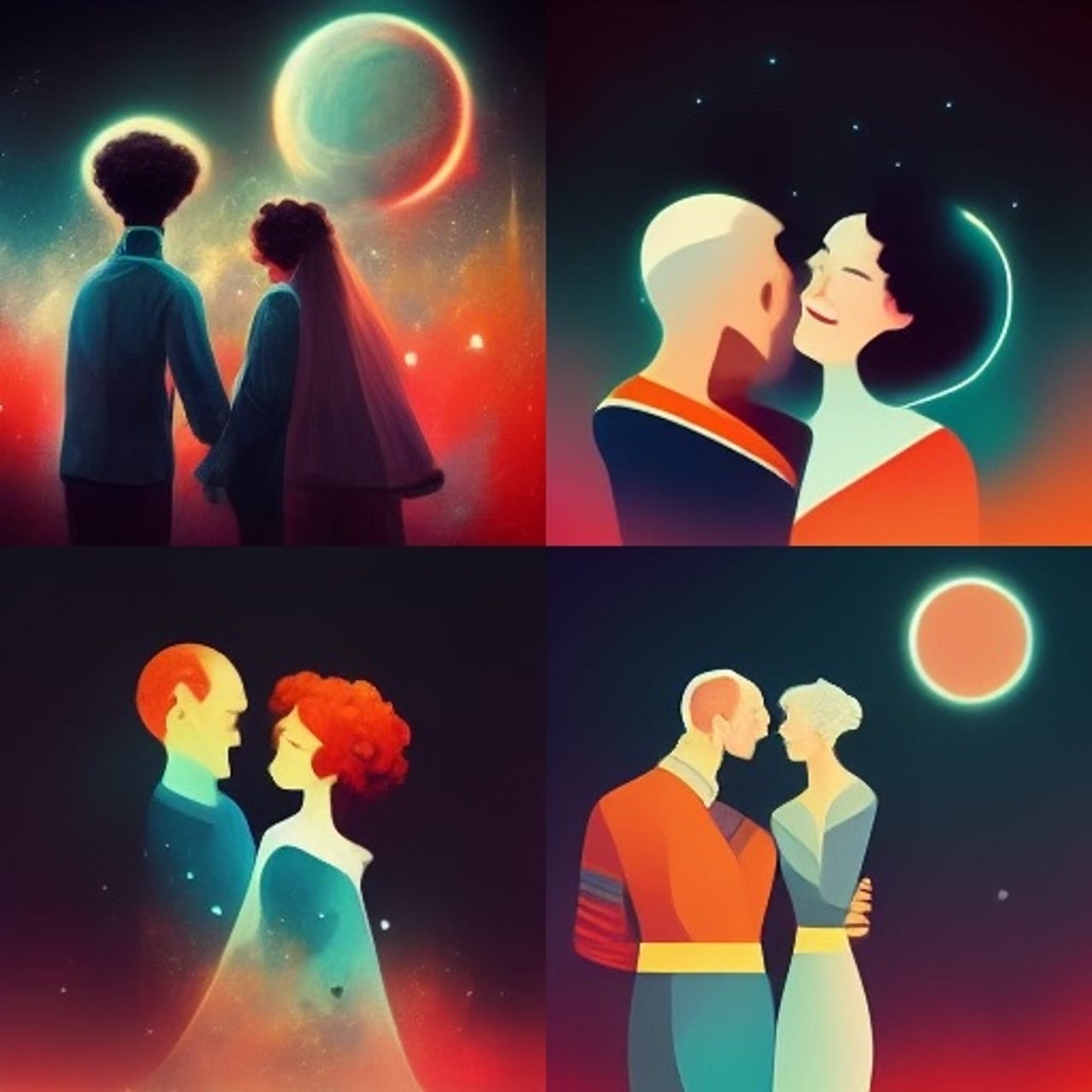I tested out an AI art generator and here's what I learned


I made these images using Midjourney.
The human creative process has historically eluded description. As American novelist and journalist Theodore Dreiser once said, "Art is the stored honey of the human soul." The 19th-century painter Vincent Van Gogh once said, "I dream of painting and then I paint my dream." For many, art draws from a deeper well of subconscious imagination.
How, then, do we fit art created by AI into that conception of art? If humanity defines art, is it enough to reduce the definition to keywords typed into a generator?
It's a question that's not theoretical any more. In late August, an AI-generated artwork won a state fine arts competition. Jason Allen entered the Colorado State Fair in the digital art category with a collection that he had selected from AI art generator Midjourney. The winning piece, "Théâtre d'Opéra Spatial" beams with potential, dominated by a glowing sun or portal and elegantly spaced figures.
Screenshot of Allen's Discord message.
How was "Théâtre d'Opéra Spatial" created?
Midjourney allows anyone to generate unique, creative pieces with just a command. The only element that the AI art generator requires from a human being is a prompt: The user types in whatever they want, and the AI gives them four new images within 60 seconds.
As long as you can access Discord, you're good to go. Midjourney is in beta mode for public use.
Allen created many images using Midjourney, narrowed down his top three, upscaled his selections, and had them printed on canvas. He announced his first place win on a Discord server, writing:
I've set out to make a statement using Midjourney in a competitive manner and wow! I could not be more excited about having won with my favorite piece "Théâtre d'Opéra Spatial"
What was the response to Allen's win?
The reaction was mixed, as you can imagine. A designer on Twitter commented that the larger issue was that "the judges didn't realize it was AI… [which] doesn't bode well for the human vs AI illustration discussion." The win was evidence of how AI can create fine art with little human input.
While Allen did fine tune the images, other digital artists point out that the AI takes elements from existing art to cobble together a new output. An artist wrote:
My problem with this is not that they 'used AI', but that using AI means that everything here was very literally stolen off a bunch of artists work in a way that not even a homage or study does.
The concerning element here is what defines creativity. Is it enough to write in a prompt, take an output, tweak it, and claim it as yours? Perhaps the prompt was your idea, maybe you typed in "Baroque in space" or "Royalty clustered around glowing sun" or something more specific, maybe you chose one output out of hundreds. Does that make the art truly your own?
Going back to the Van Gogh quote, dreaming of painting was only the starting point for him; the intention to create was not where it ended. After the dream came the action: "I paint my dream." In the harshness of daylight, dreams soften and drift away, but the artist captures them somehow. That may be an overly romanticized view of art, but isn't there something a little mystical, a little magical, about the experience of pouring out your soul on canvas?
AI-generated art takes the mystique out of ideating a new artwork, but it creates stunning, thought-provoking images all the same – and it isn't going anywhere.
How can I use AI art?
If you'd like to experiment with AI art to get inspiration for your next piece or just see what it can do, there are a couple of technologies that have come to the forefront. Midjourney, the software Allen used, is the middle ground generator. I tried it myself and entered "couple happily in love in space" as my prompt. I got the following images:
Very cute. The style is simple and vibrant, the color choices consistent.
Midjourney is free for the first 25 prompts, after which it requires a subscription. The basic plan is $10/month for 200 prompts/month, the standard is $30/month for 15 hours or 900 prompts a month, and the corporate plan is $600/year for 7,200 prompts per year.
If you click "Join the beta" on their homepage, you'll be invited to their Discord channel. From there, you can join a Bot channel, like #newbies-1, type "/imagine" and click the prompt field, then type in your command. For detailed instructions and gifs, check out the official Midjourney documentation.
A higher-end generator is DALL·E 2, which is now available in beta. This AI creates photorealistic images using a prompt that you enter, and it not only identifies objects, but learns from relationships between objects.
The images DALL·E 2 generates look like photos -- they're startlingly realistic. The koala dunking a basketball image in the video above made me think it came from an alternate reality as realistic as our own.
If you join DALL·E 2's waitlist, you could be among the first million to use the system. You get 50 free credits during your first month and 15 free credits for every month that follows. One credit equals one original prompt with four images, like Midjourney, or an edit to an existing picture, which yields three images.
The simplest generator to use, which doesn't require a subscription or Discord account or anything other than a web browser, is Craiyon.
Craiyon, formerly DALL·E mini, is an entirely free generator that uses AI to draw images from any typed prompt. It all happens in your browser, and it takes less than two minutes to generate nine images.
I tested Craiyon using a purposely more abstract prompt: "happiness." I got back the following images:
The image in the middle looks like my Betta fish before she attacks her breakfast. The face to the right of it is actively melting drops of metallic yellow. The bottom right image with pink drops in the background features a face that's just a little too close for comfort. This is an impressive array of images that elicits a reaction in the viewer. At the very least, I could see an artist interpreting one of these and using it as inspiration for their own work.
What makes art innovative?
Perhaps most interesting is that these tools are asking us again to think about exactly what is art. Is it the intention, the execution, and/or the reception of art that makes it art? Far be it from me to guard the definition: artistic expression encompasses many forms. With AI art, however, the puzzling aspect is that in selecting images and displaying them, the AI artist takes on more of a role of a curator in a digital museum of work than the standard artist who delivers the work from start to finish.
Artificial Intelligence
Isn't that the direction that art is going in, though? We're in a post-modern contemporary art period that rejects a lot of the traditional assumptions around inspiration, the nature of art, and what can be art and the role of the artist -- a process that has been going now for a century or more.
Also: Can AI help solve education's big data problems?
After experimenting with these tools, I understand the appeal. They're quick, personalized, and fun to use. Maybe art as "the stored honey of the human soul" can extend further to everything that human beings can create to draw out that sweetness. Midjourney, Craiyon, DALL·E 2, and other AI generators are indisputably innovative, and they expand the capabilities of artists.
That's one side of me. The other side feels as though the artist's intention, the tools they use to create, the labor they put into a work, should be honored and rewarded. "I dream of painting and then I paint my dream" speaks to immersion in not only the expression of art, but also the craft. Sure, anyone can marvel at colors put together the right way, but the hard work of an artist who takes the time to master techniques and create something step-by-step is the artist I want to support.
I think modernism and post-modernism back up my stance. Take Warhol's iconic silk screen printing process. According to Sotheby's, "Once he discovered the process and implications of working with silk screens, the content of Warhol's output as a painter became inextricably linked to the process by which he created his art." Content and process are inextricable, if not always visible. I wonder then, what determines if a process is valuable. Will AI generators become the next silk screen?
Watching these generators work is like seeing the mystical clouds of creativity that artists drew from and couldn't quite describe dissipate in under 60 seconds. For better or for worse, with AI generators, the process of creating innovative art moves out of the indescribable and onto the assembly line.